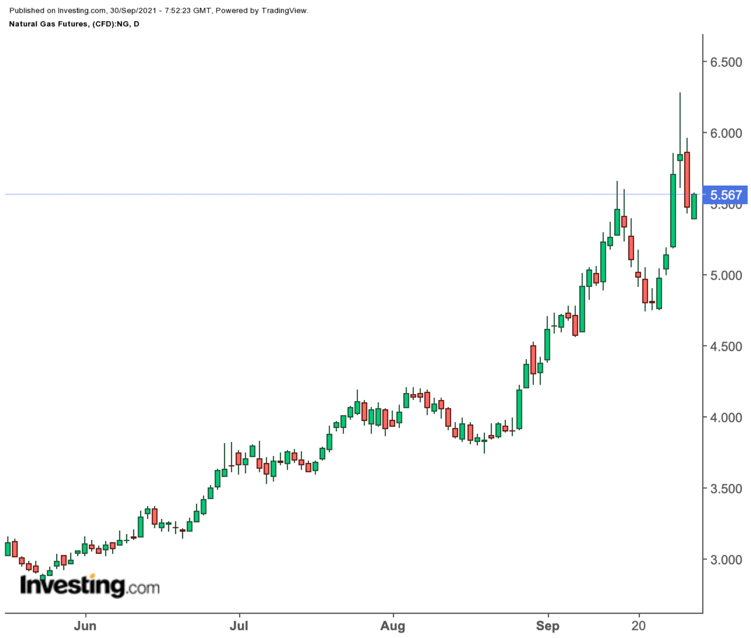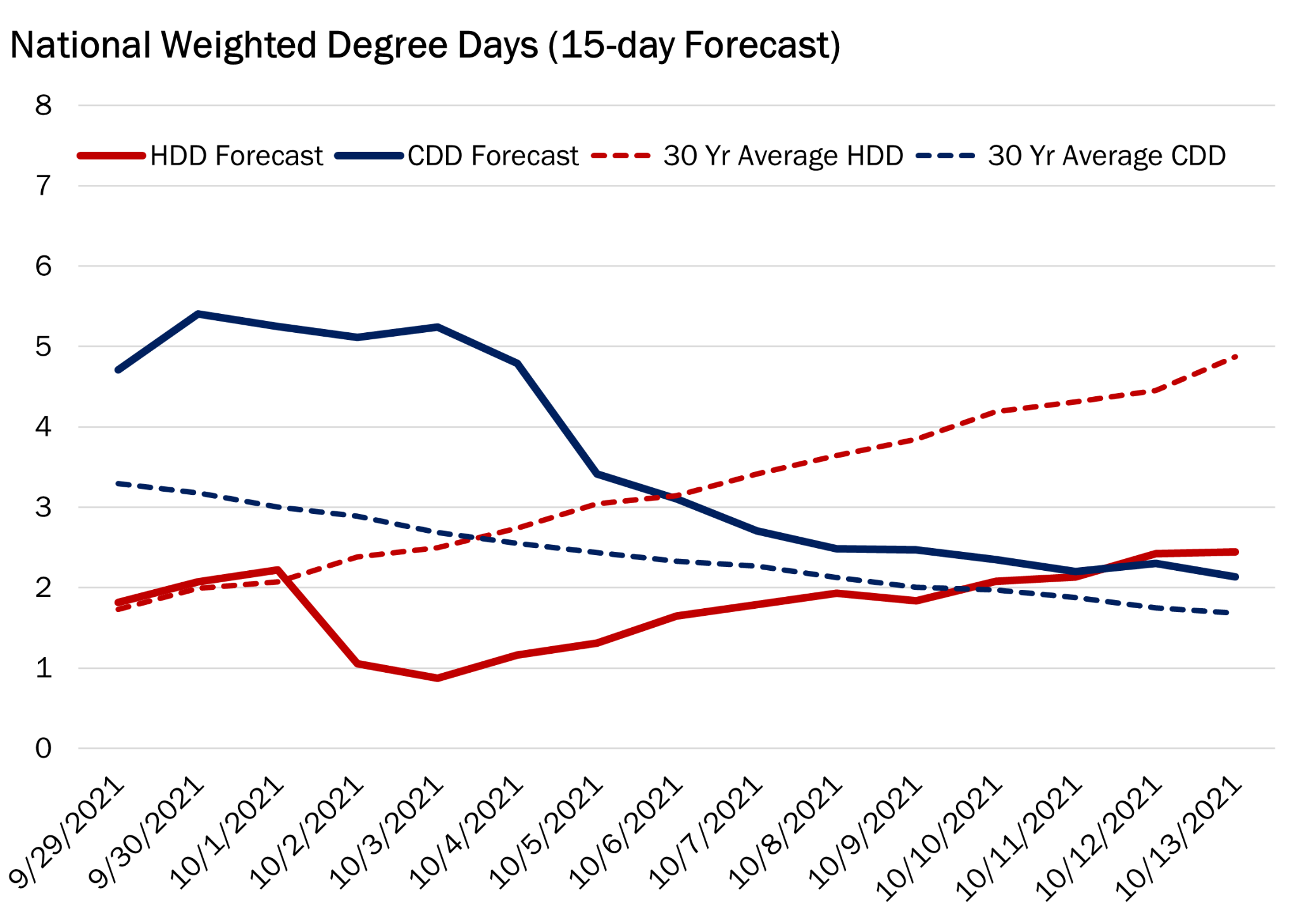Newton’s first law states that an object in motion will remain in motion; the second states that the speed of what’s in motion will depend on the force applied to it; and the third states that as forcefully as the object goes in one direction, it can reverse as well. All three laws were checked by the natural gas market this week.
On Tuesday, the expiring October contract on the New York Mercantile Exchange’s Henry Hub platform for natural gas zoomed to $6.28 per mmBtu, or million metric British thermal units—cracking in extended trading hours the much awaited $6-resistance it hasn’t neared since February 2014.
No spot contract on Henry Hub had ever closed past $4 since 2008 in the pre-shale era. Tuesday’s remarkable 20+ cent rally picked up from where the previous day’s 50+ cent run-up left off, confirming Newton’s 1st law.
The run-up came as weather forecasts since the weekend strengthened an otherwise very-mild period of demand for cooling, tamping down expectations of inventory builds deep in triple-digit territory over the next two weeks.
But the slight modulation in weather forecasts alone did not justify the magnitude of the two-day price jump.
Concerns over the strength of winter have baked a hefty winter risk premium into the market, and with international prices soaring to over $26 in Europe and $29 in Asia, the Henry Hub has ecstatically moved higher in an effort to maintain proportionality. Spikes in other energy commodities, such as crude and coal, have moved alongside that of natural gas and limited options for substitution.
These were an affirmation of Newton’s 2nd law—i.e. the force behind the motion.

All charts courtesy of Gelber & Associates
Higher natural gas prices would appear fundamentally beneficial to the bottom line of natural gas producers for the moment; however, these higher prices are causing those on the consumer end of the spectrum considerable pain. Higher prices in Europe have led to limited industrial demand abroad, with CF Industries' (NYSE:CF) factory in the UK opting to shut down.
Natural gas is a key building block to a number of products, and higher energy prices are translating into additional inflationary pressure across the international supply chain. At this rate, global pressure is growing to rein in the runaway rally of one the world’s most important fuels for both cooling and heating.
Something had to give and it naturally did: From the previous day’s high of $6.28 high, Henry’s Hub’s new spot contract, November, flew down 86 cents to a session low of $5.42 on Wednesday before finishing the session at $5.48.
This brought into effect Newton’s 3rd law: that as forceful as the rally may have been, the reversal was just as stunning (or maybe more in this case).
As I was writing this in the wee hours of Thursday in New York while Asian markets were into their lunch hour, the November contract was trying to get to a new session high beyond $5.50.
This sets up natty—the moniker used for gas in trading circles—at an inflection point as the onset of fall brings about the shoulder-season challenge, where the weather is neither hot nor cold to warrant either cooling or heating. 
The height of shoulder season typically occurs when the number of HDDs, or heating degree days, surpasses the number of CDDs, or cooling degree days.
Thirty-year HDD and CDD historical data suggest that this crossover point typically happens around Oct. 4.
Ten-year HDD and CDD historical data implies that this crossover point can be found within a range of dates from Oct. 5 to the 9.
This year, high-temperature anomalies in the Midwest and Northeast have dragged temperatures above their respective averages and limited heating demand.
Charts made available by data provider Refinitiv suggest a massive divergence between 30-year average HDDs and the actual HDD forecast.
As a result of the lower than anticipated heating degree days, the intersection point between CDDs and HDDs has been pushed back to the 12th. This implies that 2021’s shoulder season height—the day when weather-driven demand will theoretically reach its minimum—will occur later than usual.
If for any reason there’s a lack of strong, cold weather, it will result in large gas inventories as we round the bend into fall.
As the market awaits another weekly update on inventory levels, the US Energy Information Administration is expected to report that US utilities likely injected a bigger-than-normal 87 bcf, or billion cubic feet into storage last week as milder-than-normal weather led to a drop in cooling demand.
That compared with a build of 74 bcf during the same week a year ago and a five-year (2016-2020) average increase of 72 bcf.
In the prior week to Sept. 17, utilities injected a bigger-than-normal 76 bcf of gas into storage. That was the second week in a row that utilities added more gas into inventories than usual.
If analysts are on target, the injection during the week ended Sept. 24 would take stockpiles to 3.169 tcf, or trillion cubic feet, some 6.3% below the five-year average and 15.4% below the same week a year ago.
The weather last week was milder-than-normal with 58 TDDs, or total degree days, compared with a 30-year average of 65 TDDs for the period.
TDDs, used to estimate demand to heat or cool homes and businesses, measure the number of degrees a day's average temperature is below or above 65 degrees Fahrenheit (18 degrees Celsius).
According to Refinitiv, early estimates for the current week to Oct. 1 ranged from an addition of 111 bcf to 78 bcf, with a mean increase of 92 bcf.
That would compare with an injection of 75 bcf during the same week last year and a five-year average build of 81 bcf.
So, what will gas-in-storage be like as we proceed deeper into fall and, eventually, winter?
Dan Myers of Houston-based gas markets consultancy Gelber & Associates thinks there is a “strong possibility that 2021 storage will edge back towards the five-year average of total storage, as opposed to drifting away from it."
“While it is relatively impossible for total 2021 storage to actually reach the five-year average, this movement back towards it in the next few weeks may minimize additional price movement upwards,” Myers said in a note circulated on Wednesday to clients of Gelber & Associates.
Disclaimer: Barani Krishnan uses a range of views outside his own to bring diversity to his analysis of any market. For neutrality, he sometimes presents contrarian views and market variables. He does not hold a position in the commodities and securities he writes about.
Which stock should you buy in your very next trade?
AI computing powers are changing the stock market. Investing.com's ProPicks AI includes 6 winning stock portfolios chosen by our advanced AI. In 2024 alone, ProPicks AI identified 2 stocks that surged over 150%, 4 additional stocks that leaped over 30%, and 3 more that climbed over 25%. Which stock will be the next to soar?
Unlock ProPicks AI